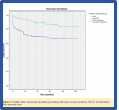In-stent restenosis and stent thrombosis rates after left main coronary artery stenting
Pogostost restenoze in tromboze v stentu po vstavitvi žilne opornice v deblo leve koronarne arterije
DOI:
https://doi.org/10.18690/actabiomed.202Keywords:
left main coronary artery disease, in-stent thrombosis, in-stent restenosisAbstract
Purpose: The aim of this study was to evaluate the in-stent restenosis (ISR) and stent thrombosis rates along with one-month and one-year survival rates in patients with left main coronary artery disease (LMCAD) with different methods of stenting, lesion characteristics, and clinical disease presentation.
Methods: A total of 297 consecutive patients with unprotected LMCAD were treated by percutaneous coronary intervention (PCI) at University Clinical Center Maribor between January 2008 and October 2016. One hundred and thirty-two (50.8%) eligible patients underwent angiographic follow-up. The majority of patients (86.5%) were treated with a single drug-eluting stent (DES).
Results: The overall prevalence of angiographic ISR in unprotected LMCA lesions was 33.3% (44 out of 132 patients with angiographic follow-up). The in-stent restenosis rate was 31.7% (39) in the group initially treated with DES (123). Most patients (63.6%) with ISR underwent repeated PCI, 22.7% had coronary artery bypass graft surgery, and 13.6% were treated conservatively. Only hypertension was shown to be statistically significant as a predictor of ISR in the present study. Stent thrombosis rate was 2.0% (six out of 297 patients). The mortality rate was 12.5% one month after the procedure on the left main coronary artery lesion, and 17.2 % after one year.
Conclusion: Patients presenting with acute coronary syndrome had worse outcomes. While the numbers in the present study are higher compared to some other studies, they represent a real-world example of patients with different clinical presentations.
Downloads

Published
Issue
Section
License
Copyright (c) 2020 Acta Medico-Biotechnica

This work is licensed under a Creative Commons Attribution 4.0 International License.